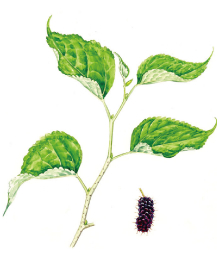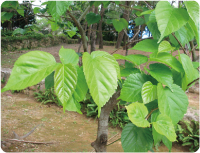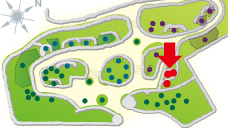Traditional Okinawa Village and Omoro Arboretum
- HOME
- Facilities
- Native Okinawan Village and Omoro Botanical Garden
- Botanical Garden exploring map
- Morus australis Poiret
Morus australis Poiret
General description

| Omoro name | Kuwage, Nadesu |
|---|---|
| Japanese name | Shimaguwa |
| Family name | Moraceae |
| Okinawan name | Kwahgi, Kwah, Kongi, Nandeshih |

Location within the park

Characteristics
Morus australis Poiret is a mid-sized deciduous and dioecious tree found from southern Kyushu and southward to Taiwan and Southeast Asia, and grows to be 16 - 20 feet tall. Its leaf is oval with a dark green, shiny face, and is 2 to 6 inches long. The young tree grows various leaves from those with large irregular cracks to those with no cracks at all. The flowering season is February and March, and the female flower grows to be 2 - 4 inches and the male flower 0.6 - 1.2 inches. Its fruit is dark red, juicy and sweet when it ripens around April.
Utilization
【leaf】 : for food, livestock feed, green manure
【fruit】 : for eating fresh, jam, liquor
【wood】 : decorative material, luxury material, bed log for Auricularia auricula-judae
【bark】 : ingredients for paper making
【leaf, root】 : medicinal use such as enhancement of urination and pain relief
【wood】 : sacred tree, silkworm rearing
About the sacred tree
As a sacred tree, the branch of mulberry tree is used to make the bow used in a ritual called “Ufuyumi” for the effect of expelling evil spirits. As the mulberry tree is also related to the sun of god, the people in Okinawa say “Kwahgi nu shita (or shicha) dehbiru (I am under a mulberry tree so please don’t strike.)” when there is a thunderstorm.
Best Time To See Calendar

Omorosaushi (1202 of Volume 17) Kuwage, Nadesu

Meaning of the song
(omitted)
In the neighboring mountain, the Kakuchiyama mountain,
Let’s plant mulberry trees
Let’s plant Morus australis Poiret
and make hand drums from mulberry trees
Let’s make hand drums that ring to welcome God and celebrate.








